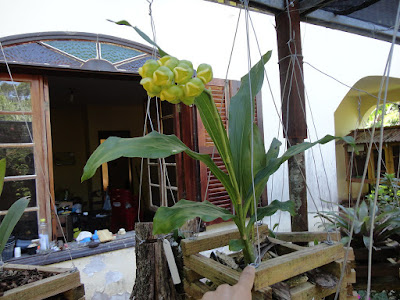Catasetum hookeri is found in Brazil, in the coastal states of Rio de Janeiro and São Paulo and in the inland state of Minas Gerais. The variety labiatum occurs in the Juiz de Fora area of Minas Gerais State and in Espírito Santo State. it grows in shady forests from sea level to about 1000 meters.
Catasetum hookeri also called as Hooker's Catasetum, Catasetum hookeri var triste, Catasetum imschootianum, Catasetum milleri, Catasetum triste, is a species of the genus Catasetum. This species was described by John Lindley in 1824.
IDENTIFY CATASETUM HOOKERI ORCHID PLANT
Catasetum hookeri is found in Brazil, in the coastal states of Rio de Janeiro and São Paulo and in the inland state of Minas Gerais. The variety labiatum occurs in the Juiz de Fora area of Minas Gerais State and in Espírito Santo State. it grows in shady forests from sea level to about 1000 meters.
It is a medium sized, hot to warm growing epiphyte with close set, fusiform to oblong-fusiform, slightly compressed, often slightly curved, to 9 cm long and 3 cm wide pseudobulbs carrying 6, plicate, 3 nerved, linear-lanceolate, acute, to 28 cm long and 6.5 cm wide leaves.
Hooker's Catasetum blooms in the late spring and summer on a basal, 18 cm long, to 9 flowered inflorescence arising on a newly matured pseudobulb carrying the flowers in an apical cluster. The flowers are 19 × 23 mm with coloration of all segments green on outside; sepals with red-brown spots forming longitudinal rows inside, showing through to the outside; petals with heavy red-brown spots and blotches over a light green background, the dark coloration on the inside visible on the outside; lip light green outside, with very dark red-brown inside and on the margins, with some yellow visible between the blotches; column tip pale green, the rest with small red-brown spots; antennae green with some spotting. The female flowers are not seen.
The key to identify this species is the floral lip held uppermost, almost entirely free, slightly enveloped by the sepals and petals. Inflorescence many-flowered, at first erect, then arching under the weight of the flowers on the apical portion. Flowers of variety labiatum generally globular in form, not opening fully, and arranged very symmetrically on short pedicels at the very tip of the inflorescence. Inside of petals and lip very dark red-brown in color. Spotting arranged in longitudinal rows on the inside of the sepals.
CATASETUM HOOKERI ORCHID PLANT CARE AND CULTURE
Cultural information should only be used as a guide, and should be to be adapted to suit you. Your physical location; where you grow your plants, how much time you have to devote to their care, and many other factors, will need to be taken into account. Only then can you decide on the cultural methods that best suit you and your plants.
Light:
Catasetum hookeri are sun-loving plant and needs a light level of 30000-60000 lux. This species should be grown in 60-80 % shade and can be grown under lights if sufficient light intensity can be provided, and the plant certainly can be summered outdoors if their moisture requirements can be met.
Temperature:
Their climate is tropical to subtropical, with dry, near desert-like conditions. It has an even longer dry season and low humidity almost year-round. Most of the moisture results from nighttime dews. Temperatures range from a maximum 40°C to a minimum 15°C. In cultivation, 18°C is the ideal minimum night temperature.
Humidity:
Hooker's Catasetum tolerate an environment with 40 - 60 % relative humidity during their growing season, but for optimal development of new growth and flowering, 70 % is recommended.
Substrate, growing media and repotting:
Catasetum hookeri can be grown in pot, container or wooden basket with fir bark, osmunda, tree fern fiber, charcoal, and sphagnum, in various proportions or combined with still other ingredients such as sponge rock, perlite, leaf mold, peat, and bark screenings as substrate.
It is recommended to repot every year and never wait more than two years. The optimal time for potting or repotting is when new growth on a plant emerging from dormancy is about 5 cm tall and the nubs have developed into new roots that are reaching for support.
Watering:
In its natural habitat it receives rainfall frequently even while dormant. Basket-grown, and unconventionally potted plant may be watered every sunny day during the growing season, provided conditions are such that they dry off relatively quickly. In the case of conventionally potted adult plants, it should not be necessary to water more than once or, at most, twice a week. This species like to dry out at least slightly between waterings.
Fertilizer:
Fertilize with an appropriate formulation at least every week during the growing season, or fertilize with a weak formula every time the plants are watered. It is important to begin regular applications of high-nitrogen fertilizer (such as 10-5-5) with a full range of trace elements. As the leaves begin to unfurl, and well before flowering, add a high-phosphorus formula to develop big, strong pseudobulbs capable of producing robust inflorescences. Any of the soluble products with a large second-digit number (for example, 3-12-6) constitute a good source of phosphorus.
Rest period:
When the Catasetum hookeri plants are leafless and no new growths are visible, the grower must respect their state of dormancy. Watering frequency should be reduced during dormancy. Fertilization should stop completely during this period. In the springtime, at the beginning of the growth cycle, water should not be made regularly available for the newly developing roots until the new growth is at least 5 cm tall.















COMMENTS